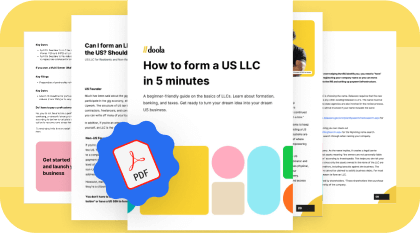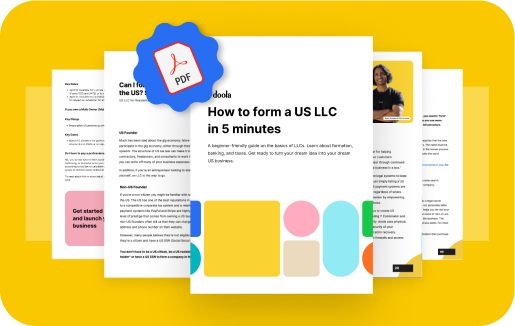Language:
Can I Write Off My Business Losses on My Personal Taxes?

If you are self-employed or work as a freelancer, your business taxes are typically reported on your personal tax return. Likewise, if you have a single-member limited liability company, you have the option of pass-through taxation to report business income and losses on your individual return. You may wonder, “Can I write off my business losses on my personal taxes?” The answer depends on the type of business structure you have.
Read on to understand reporting requirements for businesses, with tips to optimize tax savings based on business entities.
What Is Considered a Business Loss?
A business loss occurs when a business has more expenses than income in a given year or accounting period. The loss means that even if you earned significant revenue, you spent more, thus the net income of the business for the period was a loss.
How to Write Off Your Business Losses on Your Personal Taxes?
Fortunately, if you paid quarterly estimated taxes and the net income for the business for the year resulted in a loss, getting a refund is possible if your business loses money. There were
COVID-19 rules for claiming a loss on taxes, and while the pandemic is over, you may still qualify for additional deductions for losses due to casualties and theft.
Here is how to write off business losses on your personal tax return based on business type.
Sole Proprietorship
If you started a business without an LLC and work as a sole proprietor, or have a single-member LLC, you will qualify as a sole proprietor. In that case, you will need to file Schedule C to report income and expenses with your Form 1040. A Schedule C loss from your business can offset other income reported on your personal income tax return.
Partnership
If you have a partnership or a partnership limited liability company, each partner will also file Schedule C to report business income and expenses with their Form 1040. In the case of business losses, the Schedule C loss reported by each partner can offset income on their personal tax return.
LLC
If you have an LLC, you could be eligible for LLC tax benefits. If the LLC is a single-member LLC, it is treated as a sole proprietorship for tax purposes. Two-member limited liability companies are treated as partnerships for tax purposes.
In the case of a multi-member LLC, the LLC must file Form 1065, Return for Partnership Income. You may also report LLC losses on your personal tax return if you have a sufficient basis in your LLC ownership interest.
Learn more about filing LLC taxes with personal taxes, or how to file LLC taxes with no income. Need more info? Get a complete beginner’s guide to how LLCs are taxed here.
Corporation
If you have elected to have the LLC treated as an S-corporation, the limited liability company must report business losses and income by filing Form 1120-S. According to the IRS, shareholders of S corporations will report the flow-through income and losses on individual income tax returns. That means you may claim S-corporation losses on your personal income tax return as long as you have a sufficient basis for your ownership interest.
If you have a C-corporation or have elected to have an LLC taxed as a C-corporation, you will report business income and losses on Form 1120. A C-corporation is not a pass-through business entity, so you can’t report business losses on your individual income tax return.
Business Losses that Can Be Written Off
Businesses may write off losses or expenses related to their core business that are considered ordinary and necessary. Possible deductions include:
- Rent costs
- Mortgage interest
- Property tax, up to a certain amount
- Interest
- Depreciation
- Taxes
- Advertising and marketing
- Business interruption insurance
- Business meals
- Employee compensation
- Equipment
- Insurance
- Legal and professional fees
- Automobiles and related car expenses
- Capital expenses
- Charitable contribution deductions in the United States
- Cost of goods sold
- Pension plans
- Startup expenses
- Business losses
- Employee benefits
- Home office expenses
- Internet and phone bills
- Purchase of software applications and programs
- Periodic subscription payments
- Website hosting costs
- Packaging materials
- Mailing and courier costs
- Paper, toner cartridges, and printing costs
- Miscellaneous stationery like pens, pencils, staples, elastic bands, paperclips, etc.
- Legal fees
- Retainers
- Professional accounting fees
- Tax preparation fees
- Bookkeeping fees
- Payroll preparation fees
- Contractor fees
- Tradesman fees
- Marketing services and agencies
- Online advertising, media advertising, and offline advertising like billboards or newspaper ads
- Sponsorships
- Promotional design services
- Further classroom education
- Skills and vocational training
- Other education and training costs
- You can learn more about allowed business expenses here.
Limitations on Capital Losses
According to the IRS, if you don’t have capital gains to offset the capital loss, you may deduct capital loss to offset ordinary income, with a limit of up to $3,000 per year. If the business has more than $3,000 in capital losses, it can be carried forward to future tax years.
Net Operating Loss
Net operating loss occurs when tax-deductible business expenses exceed company revenue for the year. This simply means that after accounting for all expenses and income, the business operated at a loss for the year.
Tax Loss Carry Forward Rules
The IRS excess loss rule takes effect when your total business deductions are more than your total gross income and above a threshold amount of $262,000 for a single taxpayer or $524,000 for a joint tax return. Any loss over those amounts is considered excess and can’t be taken as a loss for a single year.
However, then you may use a loss carry forward, which allows your company to carry over excess loss in net operating income. The loss can be carried forward over the next 20 years. In some cases, you may be able to apply a loss carryback to the previous year’s tax return.
How to Calculate and Report Business Losses?
To calculate and report your business losses, start by accounting for all business income and subtracting all business expenses. As a sole proprietor, single-member LLC, or multi-member LLC, you will use Schedule C to report business income and losses.
If your expenses are greater than income, the company has a net operating loss. If you file as a sole proprietor or a partnership, you can use IRS Form 461 to calculate limitations on business losses and report them on your individual income tax return.
The form will ask for information about your total income and expenses for the year and then compare the excess loss limits to see if your losses will be limited.
Save More Time Filing Taxes this Year
Correctly calculating business expenses and deductions requires excellent bookkeeping throughout the year. You’ll want to keep careful records of all receipts and track allowed deductions. doola’s bookkeeping services make tracking and regular accounting easier. It is designed for busy founders to help businesses of all sizes streamline bookkeeping and file taxes more easily. Ready to get started? Get doola Books here!
FAQs
Can business losses be carried forward or back?
Depending on the business structure and filing status, excess business losses may be carried forward. A business can carry a loss forward up to 20 years. The carryover is limited to 80% of each subsequent year’s net income.
How can I determine if my business is considered a hobby or a legitimate business?
The IRS looks at various factors to determine whether a business is classified as a hobby or a business. If the business is done for the purpose of profit, earns profit, and you expect to earn profit in the future, it is usually classified as a business.
What documents do I need to support my business losses?
To document your business losses, you will need necessary receipts or general ledgers, as well as income and expense journals. If you plan to deduct travel or mileage, you will also need a travel log or mileage statement.
Keep reading
Start your dream business and keep it 100% compliant
Turn your dream idea into your dream business.














